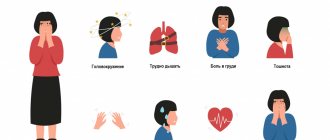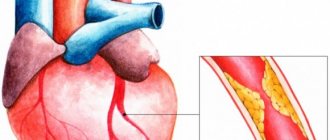Vegetovascular dystonia (VSD) is a syndrome that can be caused by the characteristics of the patient’s body or provoked by various external and internal factors. VSD often worsens in the fall. Attacks that occur every day exhaust a person and disrupt the quality of life. Drug therapy for exacerbation of VSD is often ineffective.
Doctors at the Yusupov Hospital provide preventive treatment for patients suffering from vegetative-vascular dystonia. Neurologists, endocrinologists, therapists, and gastroenterologists collectively decide on the patient’s examination regimen. Severe cases of vegetative-vascular dystonia are discussed at a meeting of the Expert Council, in which candidates and doctors of medical sciences take part. The medical staff is attentive to the wishes of patients and takes into account their emotional background.
general information
The term “vegetative-vascular dystonia” is currently not included in the International Classification of Diseases. Instead, the diagnosis “somatoform autonomic dysfunction of the nervous system” is used. In addition, a number of individual manifestations are classified as independent diseases. In our country, the old terminology is more often used.
The autonomic nervous system (ANS) is responsible for regulating the basic processes occurring inside the human body. Vital functions are under its control:
- breath;
- heart rate;
- tone of blood vessels and hollow organs;
- secretion of saliva, sweat, hormones;
- digestion of food;
- liver and kidney function, etc.
A person cannot control the functioning of the autonomic nervous system, which is why it is also called the autonomic nervous system. The functioning of various departments is regulated by a complex feedback system and also depends on the level of hormones. Failures in this mechanism lead to disruptions in the functioning of internal organs.
Make an appointment
Advantages of treating VSD at the clinic of JSC "Medicine"
Vegetative-vascular dystonia is a multifactorial disorder in the body; its successful treatment requires an integrated approach and coordinated work of doctors of many specialties. Among the undeniable advantages of JSC “Medicine” (clinic of academician Roitberg), it is worth mentioning 3 key points:
- High professionalism of doctors - the staff consists of more than 300 experienced practicing doctors and diagnosticians of 67 medical specialties. Leading corresponding members of the Russian Academy of Sciences, academicians, professors, doctors and candidates of medical sciences advise here. The clinic was the first in Russia to receive accreditation according to the international standards for assessing the quality of medical care JCI. Joint Commission International, considered the highest level of accreditation worldwide.
- Ultra-modern technical base - equipped with the latest generation diagnostic and treatment equipment from the world's leading manufacturers. This allows you to create your own scientific and clinical developments in almost all medical areas. For many years, the clinic of JSC "Medicine" has served as a clinical base for the Department of Therapy and Family Medicine of the Russian National Research Medical University named after N.I. Pirogov (RNIMU) and is among the innovatively active healthcare institutions in Moscow.
- High-quality medical care - the effectiveness and safety of treatment is guaranteed by the principle of Academician N.A. Semashko, which states: “One patient - one doctor.” The attending physician is assigned to each patient and works closely with colleagues from related medical specialties. A developed diagnostic base and medical care technology built according to international standards make it possible to make a diagnosis at an unprecedented speed. In just 1 day from the moment of the initial examination and diagnostic measures, you can receive detailed results of laboratory tests, detailed diagnostic reports and doctor’s recommendations.
It is important to know: VSD is not a critically severe disorder, but can provoke one in the absence of proper medical care. In case of early access to a doctor, treatment time is significantly reduced and financial costs are reduced. Don’t delay your visit, make an appointment at a time convenient for you, and we will help you regain your health!
Causes
Malfunctions of the ANS can be caused by various diseases and conditions. The list of the most common causes of vegetative-vascular dystonia includes:
- endocrine diseases (diabetes mellitus, hypo- or hyperfunction of the thyroid gland, etc.);
- significant hormonal changes in the body (during puberty, menopause or pregnancy);
- injuries to the brain or spinal cord (even one mild concussion can be enough to develop disruptions in the functioning of the nervous system);
- osteochondrosis of the cervical spine;
- encephalopathy of various origins;
- chronic diseases of the cardiovascular system, gastrointestinal tract;
- physical or mental fatigue;
- chronic lack of sleep;
- one-time severe stress or chronic tension of the nervous system;
- alcohol or drug abuse, smoking;
- mental illness;
- increased anxiety, hypochondria;
- use of certain medications (oral contraceptives, bronchodilators, medications based on caffeine and ephedrine);
- acute and chronic infections of the brain, kidneys, respiratory system;
- hereditary predisposition.
Changes in climate or time zones, and frequent business trips can also provoke the manifestation of VSD. Statistics show that women suffer from the disease three times more often than men. Adolescents are also at risk.
Causes and symptoms of VSD
Adolescents and women are at risk for developing vegetative-vascular dystonia. In men, VSD rarely occurs as an independent syndrome; dystonia is usually associated with other diseases. The causes of the pathology are most often unknown, but its appearance is associated with the following provoking factors:
- stress – constant nervous tension causes the release of stress hormones, which stimulate the autonomic nervous system;
- hormonal changes - physiologically in women during the menstrual cycle, with the onset of pregnancy, menopause, the concentration of sex steroids changes, which indirectly affect the functioning of the nervous system;
- maturation of the nervous system – in adolescents leads to pronounced signs of VSD;
- bad habits - smoking, drinking alcohol, caffeinated drinks cause disturbances in the functioning of blood vessels and the conduction of nerve impulses.
The first symptoms of vegetative dystonia may appear in childhood. They are associated with heredity and characteristics of pregnancy. If the expectant mother suffers from vegetative-vascular dystonia, smokes, and has been diagnosed with arterial hypertension, then the risk of pathology in the child increases significantly. The health of the baby is negatively affected by intrauterine hypoxia, disruption of feto-placental blood flow, as well as the stress experienced by the pregnant woman. Acute fetal hypoxia during childbirth can also lead to the formation of VSD at an early age.
The formation of vegetative-vascular dystonia in adults can be associated with osteochondrosis, head injuries, and poor nutrition. Prolonged life in poor environmental conditions and work in hazardous industries also leads to VSD. Weather-dependent people also often experience dystonia.
Symptoms of autonomic dysfunction are varied; doctors identify more than 40 signs of the disease, but not all of them occur in one patient. Usually this is a combination of 4-5 constant symptoms and several additional ones. Depending on the manifestations of the cardiovascular system, there are three types of vegetative-vascular dystonia:
- cardiac - not accompanied by pressure surges, it is characterized by pain in the heart area or interruptions in its work;
- hypertensive type - a person suffers from high blood pressure, which is accompanied by panic attacks, chills, and increased physical activity;
- hypotensive type – characterized by low blood pressure, which is maintained at 100/50-90/45 mm Hg. Additional concerns include weakness, drowsiness, and dizziness.
Signs of dystonia include periodic shortness of breath, a feeling of shortness of breath, or a sensation of spasm in the throat. Many people complain to the doctor about pain in the heart, a feeling of increased heartbeat, pressure in the chest, interruptions in the heart, but it is rarely possible to record them using an ECG. Symptoms of autonomic dysfunction include decreased appetite, heartburn, flatulence and other digestive disorders. The disease manifests itself in the form of frequent urination or urinary retention, chills and cold extremities, and increased sweating. Many people complain of weather sensitivity, sleep disturbances, mood swings and irritability. In women with VSD, the menstrual cycle may be disrupted or symptoms of premenstrual syndrome may appear 1-2 weeks before menstruation.
The severity of signs of vegetative-vascular dystonia may vary. Depending on the frequency of symptoms, the following types of disease are distinguished:
- paroxysmal – attacks of vegetative-vascular dystonia periodically appear;
- permanent - the symptoms of dystonia are constant, usually mild, but can intensify under the influence of provoking factors;
- mixed - includes characteristics of the two previous types;
- latent type - signs of the disease appear only after severe stress, the rest of the time the symptoms do not bother.
Vegetative-vascular dystonia, if prolonged without treatment, can lead to disturbances in the functioning of the heart. People who are overweight, eat poorly, and suffer from physical inactivity have an increased risk of developing coronary heart disease and hypertension. In women aged 45-50 years, VSD aggravates the course of menopause.
Symptoms
The symptoms of vegetative-vascular dystonia are varied, since the ANS is responsible for the functioning of all organs and structures of the human body. All manifestations of the disease can be divided into several groups:
- respiratory (respiratory): rapid breathing, subjective feeling of lack of air, inability to take a deep breath, aggravated by stress;
- cardiac (cardiac): frequent or rare pulse, interruptions (feeling of freezing) in the work of the heart, pain and a feeling of squeezing in the sternum or in the left half of the chest;
- thermoregulatory: an increase in temperature not associated with any infectious disease or inflammatory process; usually goes away on its own;
- dysdynamic: a sharp increase or decrease in blood pressure, accompanied by corresponding symptoms: headache, dizziness, flashing spots before the eyes, fainting, etc.;
- psychoneurological: increased sensitivity to changes in atmospheric pressure and temperature (meteosensitivity), drowsiness during the day and insomnia at night, apathy, irritability, causeless anxiety, fatigue;
- gastrointestinal: constipation, diarrhea or their alternation, pain and heaviness in the stomach, heartburn, increased gas formation in the intestines;
- sexual: decreased sexual desire, lack of arousal, inability to achieve orgasm, impotence in men.
The disease can cause both individual symptoms and various combinations of them. This makes it much more difficult to diagnose.
Symptoms of vegetative-vascular dystonia
In patients of different ages and genders, the disease can manifest itself in completely different ways. However, certain common features can still be identified.
Thus, common symptoms of VSD include the following:
- fast fatiguability;
- lack of air, shortness of breath, suffocation;
- difficulty or rapid breathing;
- feeling of tightness in the chest, pain in the heart;
- rapid heartbeat, arrhythmia;
- decreased appetite;
- nausea, heartburn, flatulence and other gastrointestinal problems;
- frequent urination;
- increased sweating;
- chills, coldness in the extremities, numbness;
- change in skin color (blueness, pallor, redness);
- anxiety, restlessness;
- restless sleep;
- weather sensitivity, etc.
Such manifestations not only have a detrimental effect on the emotional and physical state of patients. Finding yourself with several symptoms from this list gives good reason to visit a doctor. In addition to vegetative-vascular dystonia, the listed signs may indicate organic and cardiovascular pathology, hypertension, chronic coronary heart disease, bronchial asthma, anemia, allergies, and endocrine disorders.
Kinds
Depending on the predominant syndrome (complex of symptoms), vegetative-vascular dystonia is divided into the following types:
- hypertensive: accompanied by a short-term increase in blood pressure (within 140 mmHg), headache, rapid heartbeat;
- hypotonic: blood pressure is constantly low or decreases sporadically, which is often accompanied by severe dizziness, darkening of the eyes or fainting; patients also complain of excessive fatigue, frequent headaches and a feeling of aches throughout the body;
- cardiac: manifests itself as an increased, decreased or uneven pulse, chest pain, as well as attacks of shortness of breath, in which the patient experiences a strong feeling of lack of air;
- vagotonic: a person, first of all, complains of breathing problems: the inability to take a full breath, a feeling of tightness in the chest; the condition is accompanied by strong salivation;
- mixed: a combination of different symptoms or their alternation.
Depending on the severity, there are three types of VSD:
- mild: a person experiences symptoms rarely, they do not disrupt his lifestyle or reduce his ability to work; there are no crises;
- moderate severity: symptoms are clearly expressed and interfere with normal life activities; periodically a person may experience crises during which his ability to work decreases;
- severe: manifestations of the disease are observed almost constantly, the person cannot work normally, and is often on sick leave; vegetative crises are repeated very often.
Complications
The most common complication of VSD is vegetative crisis. This is a sudden attack during which a massive disruption of the autonomic nervous system occurs. Depending on the type of violation, there are three types of crises.
- Sympathoadrenal. Accompanied by a massive release of adrenaline into the blood, an increase in blood pressure, pulse and body temperature. The skin turns pale, hands and feet become cold and numb. The person experiences severe chills, unexplained anxiety, and fear of death. The condition is also often called a panic attack.
- Vagoinsular. The patient feels hot and suffocated, his face turns red, and severe sweating appears. Blood pressure decreases, pulse becomes rare. Often the condition is accompanied by frequent loose stools.
- Mixed. The crisis manifests itself with mixed symptoms.
If the symptoms of VSD are ignored for a long time and there is no treatment, the pathology can cause the development of:
- persistent arterial hypertension, poorly corrected by medications;
- cardiomyopathy;
- diabetes mellitus type 2;
- cholelithiasis or urolithiasis;
- stroke;
- myocardial infarction.
Excessive excitability of the autonomic nervous system also causes a decrease in immunity.
Doctors treating VSD
In addition to the attending physician, a neurologist, endocrinologist, otolaryngologist, ophthalmologist, and instrumental diagnostic specialists take part in the process of diagnosing VSD. Depending on the symptoms, you may need to consult a specialist doctor - cardiologist, gastroenterologist, pulmonologist, urologist and other related specialties.
At the clinic of JSC “Medicine”, a comprehensive approach allows us to accurately establish the mechanisms of the occurrence and development of VSD, triggers, and timely identify or exclude concomitant pathologies. Doctors of the highest category with many years of experience, doctors of medical sciences, practice here. This is the key to successful treatment, but much depends on the patient himself: how timely he sought qualified medical help, how carefully he followed the doctor’s instructions for diagnosis and treatment.
Diagnostics
Diagnosis of vegetative-vascular dystonia requires, first of all, the exclusion of another, more serious pathology with similar symptoms. The examination includes:
- interviewing the patient, collecting anamnesis to identify specific complaints, their strength, circumstances of occurrence, etc.; hereditary factors and previous diseases are also taken into account;
- examination: breathing and pulse rates are checked, an orthostatic test is performed (measurement of the heart rate first while lying down, and then 1-2 minutes after moving to a vertical position), dermographism is assessed (the color of the strip on the skin after holding the handle of a neurological hammer, indicating the activity of the or another part of the autonomic nervous system);
- laboratory diagnostics: general and biochemical blood tests, assessment of hormone levels, indicators of inflammation and autoimmune processes);
- ECG and ultrasound of the heart to exclude cardiac pathology;
- chest X-ray and respiratory function testing (spirometry), to exclude diseases of the respiratory system;
- rheoencephalography: assessment of the tone of cerebral vessels, the elasticity of their walls;
- Doppler ultrasound of the vessels of the neck and brain to assess the quality of blood flow in them;
- X-ray of the sella turcica, MRI of the brain to exclude tumors and other pathologies;
- electroencephalography (EEG): evaluates bioelectrical impulses in the brain and helps exclude epilepsy.
The patient must be examined by a therapist, neurologist and cardiologist. If necessary, consultations with other specialists are added, for example, a gynecologist, gastroenterologist, endocrinologist, psychiatrist.
Make an appointment
Treatment
Treatment of vegetative-vascular dystonia requires an integrated approach. The doctor is required to minimize the number of attacks, reduce their strength and duration. A combination of several techniques is used:
- drug treatment;
- acupuncture, as the most effective for stabilizing the autonomic nervous system
- physiotherapy, exercise therapy, massage;
- Spa treatment;
- psychotherapy if necessary.
Drug treatment is aimed at stabilizing the functioning of the autonomic nervous system, improving blood circulation and metabolism. Depending on the clinical situation, the following may be prescribed:
- sedatives of varying strength from herbal to prescription: improve the quality of night's rest, reduce stress and anxiety;
- antidepressants: help eliminate excessive anxiety, irritability, apathy; help stabilize the heart, reduce headaches and muscle pain;
- tranquilizers: necessary for severe panic attacks, unreasonable fears, high anxiety;
- nootropic drugs: improve metabolism and blood circulation in neurons of the brain and spinal cord, increase resistance to stress;
- adrenergic blockers and other antihypertensive drugs: used symptomatically for increased blood pressure and rapid pulse;
- B vitamins: improve the conduction of nerve impulses and have a beneficial effect on the state of the nervous system.
Physiotherapeutic techniques help improve blood circulation and oxygen supply to tissues. Some procedures, on the contrary, have a relaxing effect and increase resistance to stress. The patient is prescribed:
- laser therapy;
- magnetic therapy;
- electrophoresis;
- electrosleep, etc.
If necessary, drug treatment and physiotherapy are supplemented with a general strengthening complex of physical therapy, massage, and acupuncture. Psychotherapy is aimed at reducing general anxiety, stabilizing the condition, and working through internal blocks and fears.
Sanatorium-resort treatment is used outside the period of exacerbation. Patients are prescribed general restorative procedures: mud therapy, mineral water baths, etc. It is necessary to choose resorts in a similar climatic zone so that the trip does not cause an exacerbation of the condition.
What is VSD?
To explain the symptoms and treatment of VSD, it is necessary to have an understanding of the regulation of our body’s activities. The functioning of all internal organs is ensured by complex and multi-level relationships between the central and peripheral nervous systems.
The central cord includes the brain and spinal cord. The peripheral nervous system is represented by numerous nerve endings in organs and tissues. Some of them are under the conscious control of a person, for example, if you want to make some kind of movement, an impulse from the brain arrives to the nerve ending in the muscles. This section is called the somatic nervous system.
The other department is vegetative. It is responsible for the work of all internal organs and changes their activity, depending on environmental factors, physical activity of a person or his psycho-emotional status. This part of the nervous system works independently, that is, a person’s volitional efforts are not able to influence its activity.
The autonomic nervous system is responsible for the activity of all internal organs. Moreover, it also consists of two sections: sympathetic and parasympathetic. In their action, they have opposite effects on organs. For example, the sympathetic department increases the contractile activity of the heart, and the parasympathetic department reduces the frequency and strength of heart contractions.
In medicine, the term VSD is understood as a pathological condition when the normal relationship between two parts of the autonomic nervous system is disrupted. There is still no consensus among doctors about this syndrome.
Some clinicians do not consider VSD as a disease, but rather as a reversible pathological process based on dysfunction of the nervous system. At the same time, without timely correction, vegetative-vascular dystonia can develop into a disease of the heart, blood vessels, gastrointestinal tract or nervous system.
Many doctors agree that the syndrome is of a mental nature. All complaints with which the patient comes to the appointment are regarded as psychosomatic, that is, “arising” from mental and emotional disorders.
Despite disagreement about what it is, VSD requires complex treatment. The existing symptoms of vegetative-vascular dystonia have a pronounced negative impact on the condition of patients.
Prevention
Preventive measures for vegetative-vascular dystonia help increase the body's resistance to stress and strengthen the immune system. They are used not only to prevent the disease, but also as an addition to the main therapy. Doctors recommend:
- normalize the work and rest schedule, prevent overtime;
- eliminate psycho-emotional irritants as much as possible, ensure a comfortable psychological atmosphere at home;
- sleep at least 8 hours every day;
- regularly walk in the fresh air (at least 1 hour a day);
- engage in amateur sports to strengthen the body: aerobic exercise (biking, race walking) and swimming have a good effect.
Proper nutrition is also important. Recommended:
- create a diet in accordance with the principles of a healthy diet with sufficient amounts of proteins, fats, carbohydrates and microelements;
- do not exceed the daily calorie intake corresponding to age, gender and lifestyle;
- drink at least 1.5-2 liters of clean water per day;
- regularly choose foods containing large amounts of magnesium and potassium (avocado, dried apricots, bananas, almonds, broccoli, peas, spinach); they help normalize the functioning of the cardiovascular system;
- minimize the consumption of black tea, coffee, spicy, fatty, smoked foods;
- exclude alcohol.
Treatment at the Energy of Health clinic
Doctors at the Health Energy clinic choose an integrated approach to the treatment of vegetative-vascular dystonia. After a thorough diagnosis and exclusion of other pathologies, combination therapy will be prescribed, including:
- modern medications if necessary (the choice depends on the severity of symptoms);
- physiotherapy, massage and physical therapy to strengthen the body in general and the nervous system in particular;
- acupuncture, manual therapy if indicated.
We will certainly discuss your lifestyle, tell you about ways to correct it, and help you create the right diet. Regular monitoring by our doctors will help keep the disease under control.
Advantages of the clinic
The Health Energy Clinic offers each patient the highest quality medical services at an affordable price. By contacting us, you will receive:
- consultations with experienced doctors of various profiles;
- full diagnostics to identify obvious and hidden pathologies;
- a modern and effective complex treatment scheme, selected in accordance with the characteristics of your body.
Our clinic has its own day hospital, where you can undergo various therapeutic and diagnostic procedures in accordance with the doctor’s prescription. Convenient parking and location next to the metro allows you to get to us with maximum comfort.
Vegetative-vascular dystonia can be a serious problem that interferes with a full life. Do not submit to the disease, sign up for the Energy of Health clinic.
Cost of initial appointment, diagnostic examinations and treatment
As for the initial appointment, its cost in most cases is low; in fact, it is a consultation procedure. But one should not neglect its importance - an experienced doctor is able to recognize characteristic symptoms and notice even small but important manifestations of abnormalities.
The price of diagnostic procedures and laboratory tests may vary significantly in different clinical cases. For one patient, general tests and several examinations will be enough; for another, diagnosis may take longer and require additional studies and tests. This is due to both the complex nature of VSD and the individual characteristics of each patient’s body.
A similar picture is typical for treatment. Its cost is determined by many factors; sometimes the therapeutic process has to be adjusted. To roughly navigate the prices for diagnosis and treatment of VSD in Moscow, you can familiarize yourself with the corresponding table of costs for the most common diagnostic procedures.










